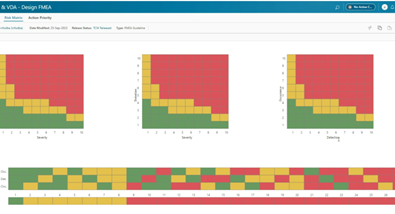After-sales BOM and Configuration

Is management and configuration of your after-sales BOM an element of your PLM strategy today? I’ve previously talked about the Integrated Product Definition (IPD) approach for BOM management and BOM configuration in Teamcenter. An important aspect of IPD is that it provides the bill of materials (BOM) and configuration management capabilities in the PLM system to enable serving a broader set of user communities within the enterprise, beyond engineering. My colleague, Amy Strucko, introduced a series of discussions focused on the role of Configurator Software for total variability management. In this article, I’d like to extend that discussion to explore the types of needs and challenges that product definition for after-sales service presents to product configuration and BOM management.
The user communities within a typical discrete manufacturing enterprise that define product information relevant to after-sales are focused on product aspects such as serviceability, spare parts, repair kits, after-market components, training, and user manuals, etc. While form, fit, and function of parts and assemblies are definitely fundamental concerns in these activities, there are several other factors in play as well.
After-sales BOM Considerations
A BOM released by the engineering department usually does not document all after-sales and service considerations. It is typically the job of after-sales BOM planners to do so while consuming the engineering bill of materials and its evolution through changes. A BOM release for service and after-sales builds on engineering release information and applies several additional considerations to ensure the product’s readiness for after-sales and service activity in all markets. The BOM as released for after-sales serves as basis for creation and update of manuals, service procedures, service plans, parts catalogs, service bulletins, installation guides, etc. and is a critical part of market readiness of the product.
Several unique considerations exist in documenting an after-sales BOM. I can relate a few of these here… An engineering released assembly may or may not be serviceable in the field. Whether and how it is serviced can depend on engineering considerations as well as readiness for service based on spare part availability, sourcing, cost, etc. – for example, an after-sales decision may be to service an assembly only in certain geographies where replacement parts can be made The service strategy for the assembly may require additional levels of the bill of material component details, as relevant for service. Sometimes, replacement of certain parts will mandate replacing other related parts as well, such that these parts have to be always considered together from an after-sales BOM documentation standpoint. Other considerations include aftermarket parts which are always installed in dealerships and never in a manufacturing plant. Repair kits bundle tools and specific sets of related parts that are always shipped together for service purposes and these are to be documented in the after-sales BOM as released by the planners.
As you can see, fully documenting and releasing a bill of materials that is fit for after-sales and service applications requires addressing several factors that are usually not critical for engineering completeness. The ability to do so in a manner that is integral to or closely aware of the engineering BOM would ensure that there can be more effective ‘consumption’ of the engineering BOM as well as provide after-sales specific feedback to engineers earlier in the product lifecycle.
Configuration Considerations for After-sales
While considering a configuration or set of related configurations as specified by engineering, after-sales planning factors may weigh these configuration groupings differently. Service specifications on certain parts and assemblies may be the same globally while others may vary based on geography, cost, supply considerations. Hence, identifying and grouping configurations from an after-sales standpoint and the flexibility to do so while retaining engineering intent is especially important for efficient planning and communication of after-sales decisions.
Aftermarket options are another consideration. In many manufacturing enterprises, after-sales and service are lucrative profit centers. Offering and supporting an attractive set of aftermarket options often adds significant market momentum to the core product.
Certain engineering options are only ever intended to be used in service or repair and never in the original product. These could be due to considerations such as accounting for wear on the original part, repair strategies, etc. and these add special configuration combinations to consider, plan and account for.
In general, the configuration system needs to be able to address the validity and compatibility of options for repair and configuration management, and BOM systems in conjunction need to be able to associate these configuration conditions with the relevant engineering. It is critical for systems and personnel that run after-sales service operations to be able to dynamically derive the product BOM as applicable to the specific configuration and in many cases the specific unit, of the product that is being serviced to ensure that the correct replacement parts and services operations are known and available.
The Integrated Product Definition (IPD) approach for After-sales BOM
Integrated Product Definition (IPD) provides key configuration and product definition constructs that allow service planners to access and augment engineering BOM with service relevant records such that a view of the engineering BOM as relevant for after-sales and service can be derived directly rather than through a ‘copy and reconcile’ approach.
The configurator in Teamcenter provides a master repository of options, their scoping to specific product contexts, and their compatibility within a context. IPD provides the ability for multiple disciplines to collaboratively author this configuration definition, capturing information relevant to each domain within the master configuration information, thus representing configuration decisions from across the enterprise. This ‘centrally sourced’ configuration information can be applied to qualify product content from these multiple disciplines (such as parts, designs, process plans, service kits, etc.) as relevant for particular configurations.
Service-specific augmentation of engineering BOM information may include:
-
- Addition of levels of component detail to engineering assemblies
-
- A restructure of engineering assembly breakdowns
-
- Serviceability indicators
-
- Market-specific service decision records on specific parts and assemblies
-
- Creation of service only parts, repair kits
-
- And more!
This information is authored either directly on or with a relationship to engineering authored master records. It is available to the core engine that constructs a relevant after-sales BOM view.
Thus, Teamcenter’s Integrated Product Definition approach promotes a collaborative approach that enables better information flow between after-sales BOM planners and core product development engineers, enabling greater efficiencies and value for the entire product lifecycle.
Other discussions in this series include:
Beyond Product Configurator Software: Total Variability Management
Configurator for Product Management and Planning
Configurator for Engineering and Manufacturing
Configurator for Enabling Customer Choice
Configurator for Service Organizations
Accelerating Lead Times for Engineer to Order (ETO) Processes


